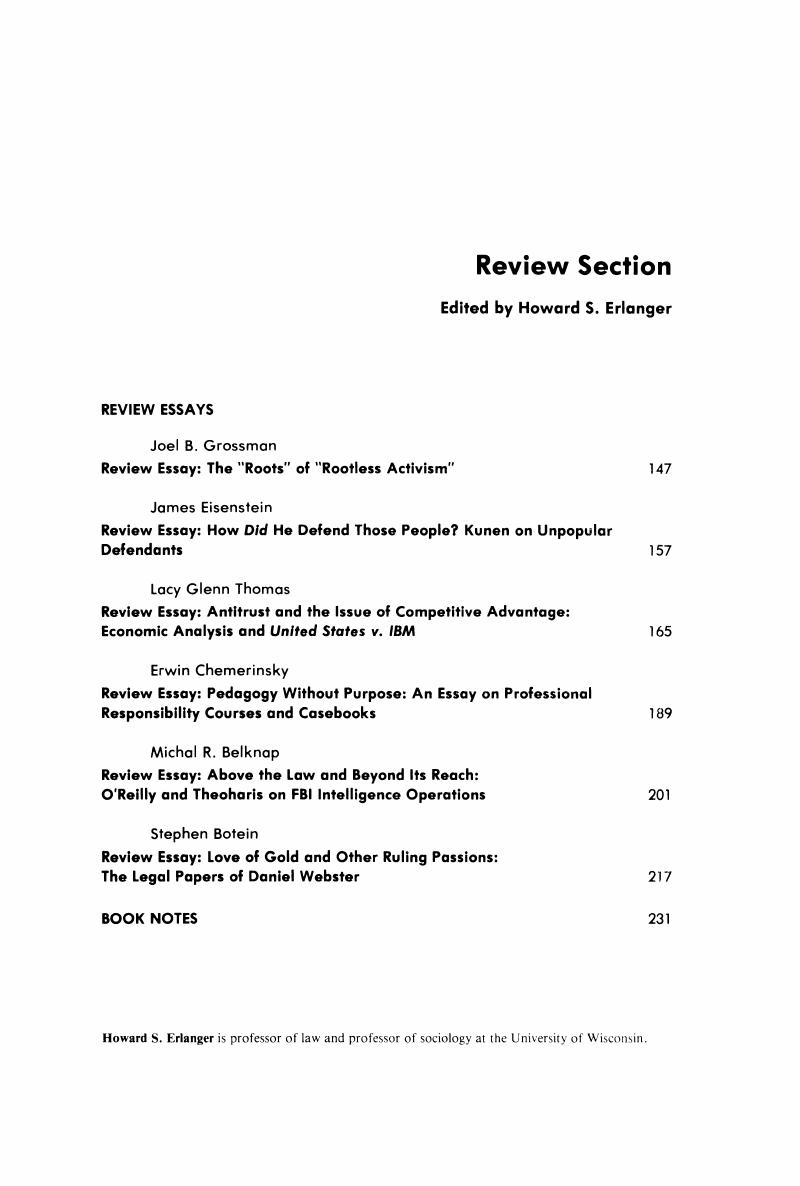No CrossRef data available.
Article contents
The “Roots” Of “Rootless Activism”
Published online by Cambridge University Press: 20 November 2018
Abstract

- Type
- Review Essays
- Information
- Copyright
- Copyright © American Bar Foundation, 1985
References
1 See Grossman, Joel B. & Wasby, Stephen L., The Senate and Supreme Court Nominations: Some Reflections, 1972 Duke L.J. 557.Google Scholar
2 United States v. Nixon, 418 US. 683 (1974).Google Scholar
3 See Canon, Bradley, Defining the Dimensions of Judicial Activism, 66 Judicature 236 (1983).Google Scholar
4 Shapiro, Martin, Fathers and Sons: The Court, the Commentators, and the Search for Values, in Blasi.Google Scholar
5 392 U.S. 1 (1968).Google Scholar
6 394 U.S. 618 (1969).Google Scholar
7 397 U.S. 471 (1970).Google Scholar
8 Reich, Charles, The New Property, 75 Yale L.J. 1227 (1965).Google Scholar
9 Bender, Paul, Is the Burger Court Really Like the Warren Court? 82 Mich. L. Rev. 635, 640–41 and possim (1984).Google Scholar
10 Mapp v. Ohio, 367 US. 643 (1961); Miranda v. Arizona, 384 U.S. 436 (1966); Brown v. Board of Educ., 347 U.S. 483 (1954); Baker v. Carr, 369 U.S. 186 (1962); New York Times v. Sullivan, 376U.S. 254 (1964).Google Scholar
11 418 U.S. 166 (1974).Google Scholar
12 454 U.S. 464 (1982).Google Scholar
13 392 U.S. 83 (1968).Google Scholar
14 401 us. 37 (1971).Google Scholar
15 Simon v. Eastern Ky. Welfare Rights Org., 426 U.S. 26 (1976).Google Scholar
16 See Olson, Susan M., Clients and Lawyers: Securing the Rights of Disabled Persons (Westport, Conn.: Greenwood Press, 1984); Joel Handler, Social Movements and the Legal System: A Theory of Law Reform and Social Change (New York: Academic Press, 1978).Google Scholar
17 Chayes, Abram, The Supreme Court, 1981 Term—Foreword: Public Law Litigation and the Burger Court, 96 Harv. L. Rev. 4 (1982); Council on the Role of Courts, The Role of Courts in American Society (St. Paul, Minn.: West Publishing Co., 1984), and the works cited therein.Google Scholar
18 Kirby v. Illinois, 406 US. 682 (1972).Google Scholar
19 Kirby v. Illinois, U.S. — (1984).Google Scholar
20 United States v. Leon, 468 US. — (1984); Massachusetts v. Sheppart, 468 U.S. — (1984); Nix. v. Williams,— U.S. — (1984).Google Scholar
21 Brown v. Board of Educ., 347 U.S. 483 (1954).Google Scholar
22 369 U.S. 186 (1962).Google Scholar
23 Mahan v. Howell, 410 U.S. 315 (1973).Google Scholar
24 412 U.S. 735 (1973).Google Scholar
25 Scheingold, Stuart, The Politics of Rights (New Haven, Conn.: Yale University Press, 1974).Google Scholar
26 Cf. Shapiro, supra note 4.Google Scholar
27 468 U.S. —, 82 L. Ed. 2d 462 (1984).Google Scholar
28 Bender, supra note 9, at 637; Milliken v. Bradley, 418 U.S. 717 (1974); Board of Regents v. Bakke, 438 U.S. 265 (1978).Google Scholar
29 Washington v. Davis, 426 U.S. 229 (1976).Google Scholar
30 Personnel Administrator v. Feeney, 442 U.S. 256 (1979).Google Scholar
31 Mobile v. Bolden, 446 U.S. 55 (1980); but cf. Rogers v. Lodge, 458 US. 613 (1982).Google Scholar
32 Sarat, Austin, Studying American Legal Culture: An Assessment of Survey Evidence, 11 Law & Soc'y Rev. 427 (1977); Herbert McClosky & Alida Brill, Dimensions of Tolerance (New York: Russell Sage Foundation, 1983).Google Scholar
33 Firefighters Local #1784 v. Stotts, — U.S. — (1984).Google Scholar
34 Milliken v. Bradley, 418 U.S. 717 (1974); Pasadena City Bd. of Educ. v. Spangler, 427 U.S. 424 (1976); Washington v. Seattle School Dist., 458 U.S. 457 (1982); Crawford v. Los Angeles Bd. of Educ., 458 U.S. 527 (1982); Green v. New Kent County, 391 U.S. 430 (1968).Google Scholar
35 Much of this depends on how the Court's opinion in Firefighter's Union #1784 v. Stotts, — U.S. — (1984) is interpreted. In subsequent litigation the Dep't of Justice has interpreted it to mean that affirmative action remedies are appropriate only to redress individual harm, and not merely to redress grievances of an historically oppressed group or class. This “expansive” interpretation would seriously undermine affirmative action efforts.Google Scholar
36 See Shapiro, , supra note 4.Google Scholar


